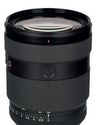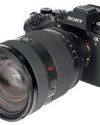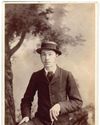
With a five-year head start over Canon and Nikon in building its full-frame mirrorless system, it’s no surprise that Sony has a significantly larger lens range than its two biggest competitors. But there’s one lens type that both it's rivals managed to bring out earlier – a 35mm f/1.8. Both introduced such a lens on day one of their systems, whereas Sony started out with a compact 35mm f/2.8 in 2013, then added a huge, premium 35mm f/1.4 in 2015, before revealing its f/1.8 optic in July.
Interestingly, the three firms have come up with somewhat different takes on the idea. Canon’s RF 35mm F1.8 IS STM Macro is an optically stabilised lens that uses an extending-barrel design to achieve half-lifesize magnification at the cost of outright focusing speed. In contrast, the Nikon Nikkor Z 35mm f/1.8 S is a large optic that includes more exotic glass for premium performance.
Sony’s FE 35mm F1.8 is smaller than the Nikon and has a lower RRP, suggesting slightly lower aspirations. Indeed with a launch price of £630, the FE 35mm F1.8 sits alongside the FE 28mm F2 and FE 85mm F1.8 in Sony’s mid-range line-up. Tellingly, it’s cheaper than the 35mm f/2.8, and less than half the price of the 35mm f/1.4. Crucially, its relatively compact design makes for a nicely balanced match with the A7 camera bodies.
Features
Optically, the FE 35mm F1.8 employs 11 elements in 9 groups, including a single aspherical element to suppress aberrations and achieve higher sharpness towards the corners of the image. A 9-bladed diaphragm provides a circular aperture, with the aim of producing attractive out-of-focus highlights.
This story is from the September 28, 2019 edition of Amateur Photographer.
Start your 7-day Magzter GOLD free trial to access thousands of curated premium stories, and 9,000+ magazines and newspapers.
Already a subscriber ? Sign In
This story is from the September 28, 2019 edition of Amateur Photographer.
Start your 7-day Magzter GOLD free trial to access thousands of curated premium stories, and 9,000+ magazines and newspapers.
Already a subscriber? Sign In

Calling The Shots: A Queer History of Photography
Offering an unprecedented view of photographic history through a queer lens, this is a wonderful and powerful book, says

Large-aperture standard zoom, too
SONY has also revealed a new premium standard zoom, the FE 28-70mm F2 GM.

Super-fast, high-res Sony Alpha Ai II
SONY has announced its new professional full-frame flagship camera, the Alpha A1 II.

39 awesome accessories
Our round-up of the best accessories we've used and reviewed this year, along with some old favourites. There's something here for every budget, starting from just £7, including tripods, bags, filters and much more

Such a thing as society
This autumn sees the launch of a major new book and exhibition devoted to examining the multiplicities of photography during 1980s Britain. Peter Dench finds out more

Join Club
The sociable Canvey Island Photographic Club is keen to grow its in-person meet ups

Capturing flight
Winners and finalists of Bird Photographer of the Year share their tips for success with Hollie Latham Hucker

140 years of change
AP has become the world’s oldest surviving consumer photo magazine because we have moved with the times, says Nigel Atherton

Preserving history in platinum
A deep dive into the meticulous art of platinum printing, and the collaboration between the Royal Geographical Society and Salto Ulbeek. Mike Crawford explores how they brought historical photographs to life with enduring beauty and precision

Life in the past lane
What was life like for an amateur photographer in 1884? John Wade takes a trip back in time